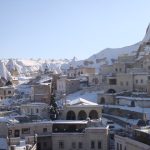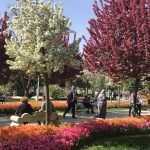Once upon a time there was a small town called Demre on the south coast of Turkey midway between Fethiye and Antalya. Demre had two main claims to fame, which were the rock-cut Lycian tombs that overlooked an ancient theatre at nearby Myra and the remains of a rather battered Byzantine church dating back to the 3rd century. Demre was a sleepy little place, visited by coach groups that tended to home in on the ruins before rushing on to their next port of call on a whistlestop tour of the coast. It certainly didn’t realise that it was sitting on a commercial goldmine in the unlikely shape of the western Father Christmas.
Then gradually something started to happen. Word started to spread that the church at Demre was the burial place of St Nicholas. Yes, that St Nicholas. The St Nicholas who is famous the world over in his alter ego as Santa Claus, AKA Father Christmas.
Since then all hell has broken loose in Demre, now mysteriously and confusingly renamed Kale (Castle). Today busload upon busload of tourists pours into town to take a quick look at a church that is revered by many as a shrine. The result is that what was once a pretty minor tourist attraction is now surrounded by a sea of stalls touting souvenirs in all shapes and sizes. It’s tacky not just with a capital T but with a capital A, C, K and Y, too. And right in the middle sits a statue of the supposed progenitor of it all, a jovial, bearded Father Christmas just as he would appear on top of the Christmas cake – except that somewhere along the way someone seems to have confused him with a medieval town crier so that instead of carrying a sack of lovely presents he’s waving around a handbell. Ho, ho, ho, ho, ho! All the better to summon the kiddy-winks with, one can only assume.
And the truth is…
The real St Nicholas seems to have been a bishop of Myra who was born at nearby Patara in 245. He is credited with having taken pity on a father with three daughters for whom he couldn’t afford dowries, leaving them in danger of being forced into a life of prostitution. St Nick is said to have tossed enough largesse through the window to enable them to get married, an act of generosity for which he won his Father Christmas spurs. When he died in 343 he was supposedly buried inside the local church, although what is pointed out as his tomb today actually looks very much like the much older tomb of some long forgotten Byzantine couple. In any case he is no longer resting in peace on the site, dastardly Italian pirates having stolen his bones in 1087 and carried them away to Bari in an attempt to cash in on the lucrative pilgrimage trade. They remain there to this day.
Whose image is it anyway?
The Russians became particularly hung up on the legend of St Nick, and in 1862 Tsar Nicholas I paid for repairs to the church of his namesake. Today it’s the Russians who are the most avid consumers of all things Nicholasian, and they take it all very seriously too. Amid all the terrible tat on sale in Demre the single largest souvenir shop actually majors in icons of the saint, which offer barely a nod in the direction of the overblown Santa Claus shindig.
Unfortunately the Russians took St Nicholas so seriously that they donated a serious bronze statue of him designed by the sculptor Gregory Pototsky to celebrate the year 2000. There was already one statue in the church garden, but this showed a hooded man with a sack of goodies ready to dole out to small children. It was a discreet and adult rendering of the story of Father Christmas that was unlikely either to offend or inspire anybody. The new Russian statue, however, depicted the saint as a bishop and some visitors started to pray in front of it with predictable consequences: the authorities panicked, the statue was sidelined and in its place came the current vacuously commercial and childishly unthreatening version that now greets visitors. Obviously the politics of religion lay at the heart of the swap, which created a mini-stir in the international media, but at the same time people who know Turkey well will recognise that the jaunty Santa in his red and white gear is far more in keeping with the general standard of public statuery, most of which appears to have been designed by and for the least artistically gifted of under-10-year-olds.
The Myra alternative
No one would seriously suggest that anyone should come all the way from İstanbul to Demre/Kale just to visit the church, especially since the irritatingly inevitable consequence of all the hype is an admission fee of 10YTL which in no way reflects the short time it will take you to whip round it and be out again. On the other hand you might want to consider coming down here to visit Myra, a fine historic site albeit swallowed up amid the market gardens of the suburbs. The Greco-Roman theatre is impressively intact and is backed by a wall of rock into which are cut many of the same temple-like Lycian tombs as can be seen in Dalyan and Fethiye. They make the perfect antidote to the tackiness of downtown Demre, after which you will probably want to be on your way out towards Kaş or Olympos as soon as you possibly can.
Word to the wise
Pack a copy of Jeremy Seal’s Santa, which will fill you in on how the cult of a saint born in Turkey ended up in letters to Santa c/o the North Pole, and in sleigh rides to Lapland.

